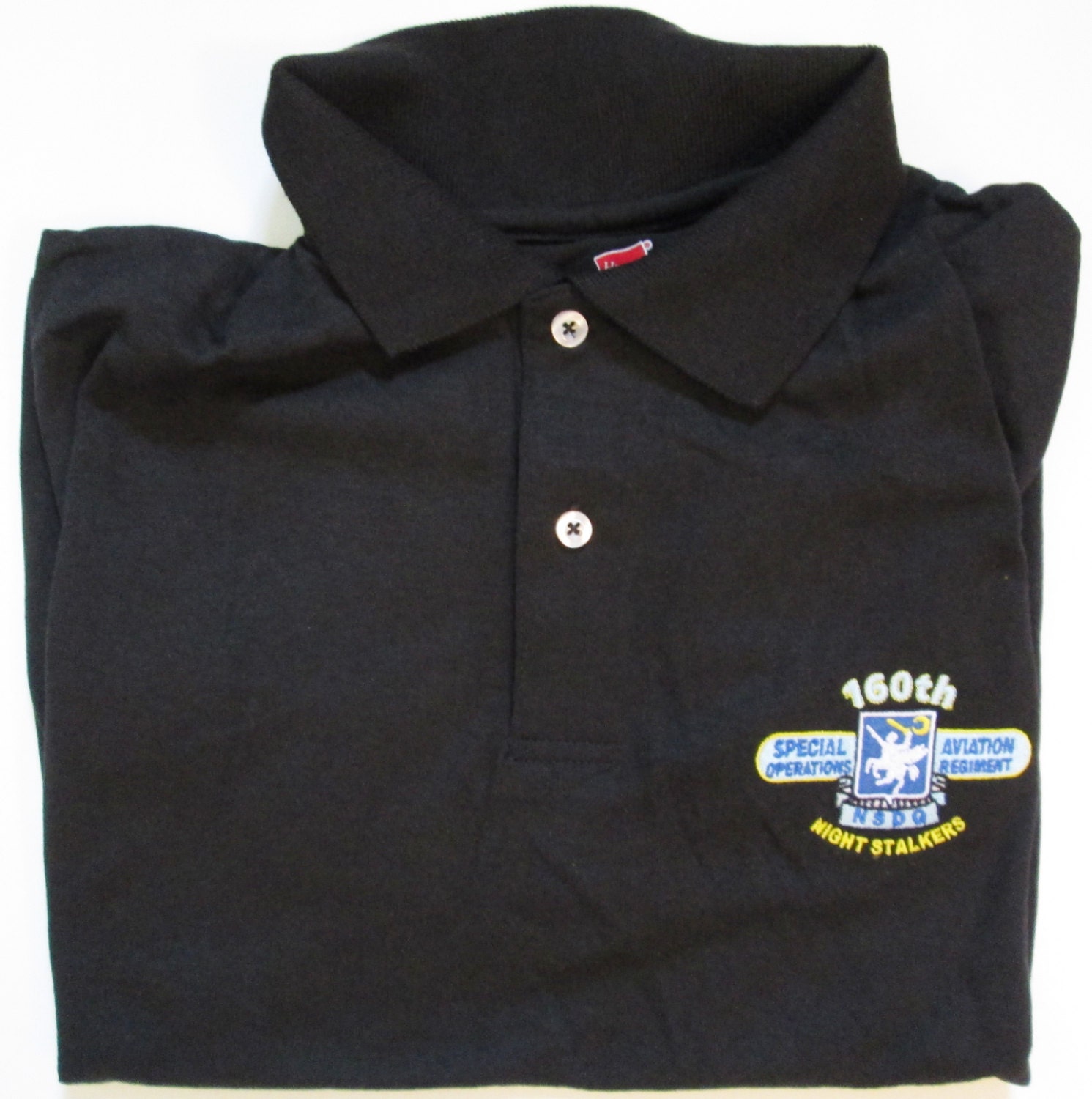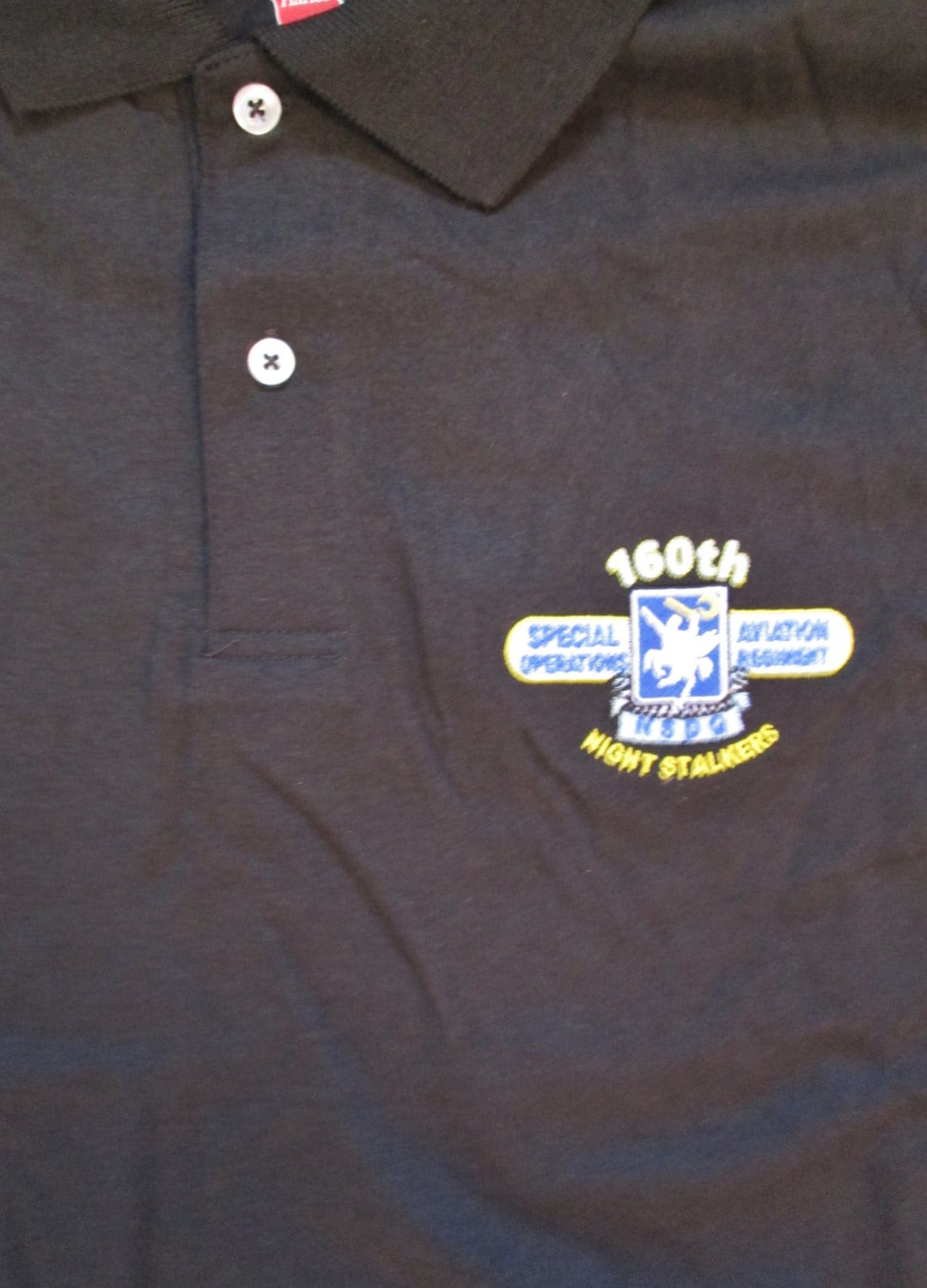160th SOAR Special Operations Aviation Regiment" Night Stalker" Embroidered Light Weight Black Polo Shirt
$40.45 $44.95
The United States Army 160th Special Operations Aviation Regiment (Airborne), also known as Night Stalkers, is a special operations force of the United States Army that provides helicopter aviation support for general purpose forces and special operations forces. Its missions have included attack, assault, and reconnaissance, and are usually conducted at night, at high speeds, low altitudes, and on short notice. The 160th SOAR is headquartered at Fort Campbell, Kentucky.
Contents
[hide] 1 Overview
2 Equipment
3 History 3.1 List of operations
4 Organization
5 See also 5.1 Comparable non-US units
6 References
7 External links
Overview[edit]
The regiment consists of four "operations" battalions: the 1st and 2nd at Fort Campbell, the 3rd at Hunter Army Airfield, Georgia, and the 4th at Joint Base Lewis-McChord, Washington.
The 160th SOAR (A) consists of the Army's best-qualified aviators and support soldiers. Officers volunteer while enlisted soldiers volunteer or are assigned by the U.S. Army Human Resources Command. All soldiers receive intensive training upon joining the 160th and are required to pass the Green Platoon course.[2] The basic Night Stalker course for enlisted soldiers lasts five weeks; the officer course lasts 20 to 28 weeks. A new Night Stalker arrives to his unit Basic Mission Qualified (BMQ), after a series of test qualifications, experience and leadership, the Night Stalker is designated Fully Mission Qualified (FMQ). After three to five years as an FMQ, the Night Stalker will have the chance to assess for flight lead qualification. The 160th recruits women, though only for staff positions.[3]
Equipment[edit]
U.S. Navy Sailors from the USS Bataan (LHD-5), stand-by as two U.S. Army MH-60L Blackhawk helicopters, 160th Special Operations Aviation Regiment (SOAR) prepare to land in 2006.
An MH-6 Little Bird from 160th SOAR carrying Special Forces Soldiers from the 5th SFG(A) prepares to land during a SOF aerial infiltration demonstration 28 Sept. at NASCAR's Kansas Speedway 400.
The 160th SOAR fly MH-47G Chinooks, A/MH-6M Little Birds, MH-60K Black Hawks and MH-60L Black Hawks.
Aircraft Type
Inventory[4]
MH/AH-6M Little Bird 51
MH-47G Chinook 61
MH-60M Black Hawk 72
Total 184
History[edit]
After the 1980 Operation Eagle Claw attempt to rescue American hostages held in Tehran, Iran, President Jimmy Carter ordered former Chief of Naval Operations Adm. James L. Holloway III to figure out how the U.S. military could best mount another attempt. At the time there were no U.S. helicopter units trained in this kind of stealthy, short-notice Special Operations mission.
160th SOAR Insignia
The Army looked to the 101st Aviation Group, the air arm of the 101st Airborne Division (Air Assault), which had the most diverse operating experience of the service's helicopter units, and selected elements of the 158th Aviation Battalion, 229th Aviation Battalion, and the 159th Aviation Battalion. The chosen pilots immediately entered intensive training in night flying.
This provisional unit was at first dubbed Task Force 158 since the majority of the pilots were Blackhawk aviators detached from the 158th. Their distinctive 101st "Screaming Eagle" patches remained on their uniforms. The Blackhawks and Chinooks continued to operate around Campbell Army Airfield at the north of post, and Saber Army Heliport at the south. The OH-6 Cayuse "Little Birds", an aircraft vanished from the Division's regular inventory after Vietnam, were hidden out by the ammunition holding area at spot still known as the "SHOC Pad", for "Special Operations Helicopter Company".
As the first batch of pilots completed training in the fall of 1980, a second attempt to rescue the hostages was planned for early 1981. Dubbed Operation Honey Badger, it was called off when the hostages were released on the morning of President Ronald Reagan's inauguration.
The capability gained was judged too important to future contingencies to lose. The new unit was quickly recognized as the Army's premier night fighting aviation force, and its only Special Operations Aviation force. The pilots and modified aircraft would not be returned to the 101st. Original members of the Night Stalkers refer to it as "the day the Eagles came off". The 101st's patches came off, the personnel and equipment would be reassigned, and a new tradition was born. The unit was officially established on 16 October 1981, when it was designated as the 160th Aviation Battalion.
The 160th first saw combat during 1983's Operation Urgent Fury, the U.S. invasion of Grenada.
The crew of Super 6-4 one month before the Battle of Mogadishu. From left: Winn Mahuron, Tommy Field, Bill Cleveland, Ray Frank and Michael Durant.
In 1986, it was re-designated as the 160th Aviation Group (Airborne); and in May 1990, the 160th Special Operations Aviation Regiment (Airborne). As demand for highly-trained Special Operations Aviation assets bloomed, the regiment activated three battalions, a separate detachment, and incorporated one Army National Guard unit, the 1st Battalion, 245th Aviation (OK ARNG).
In 1987 and 1988, its pilots took part in Operation Earnest Will, the protection of re-flagged Kuwaiti tankers in the Persian Gulf during the Iran–Iraq War. They flew from US Navy warships and leased oil barges in a secret sub-part called Operation Prime Chance, and became the first helicopter pilots to use night vision goggles and forward looking infrared devices in night combat.
In June 1988, the unit executed Operation Mount Hope III. Two MH-47 crews flew 490 miles (790 km) deep into Chad to retrieve a crashed Mi-24 Hind medium-attack helicopter.
The Night Stalkers spearheaded Operation Just Cause, the 1989 invasion of Panama, and they were also used in Operation Desert Storm in 1991.
In October 1993 in Somalia, Night Stalkers became involved in the Battle of Mogadishu, which later became the subject of the book Black Hawk Down, and its film adaptation. Two Night Stalker Black Hawks, Super 6-1 (piloted by Cliff Wolcott), and Super 6-4 (piloted by Mike Durant), were shot down in the battle. Five of the eighteen men killed (not counting a nineteenth post-operation casualty) in the Battle of Mogadishu were members of the SOAR(A) Night Stalkers team, who were lost along with the two Black Hawks.
Afghanistan 2001: On 19 October an MH-47E carrying ODA 595 landed at Dehi. They flew over 150 miles from Karshi-Khanabad (K2) in Uzbekistan. A few weeks later ODA 595 and ODA 555 along with the Northern Alliance retook the city of Mazari Sharif from the Taliban.
In December the same year Night Stalker crews were essential in resupplying over 150 Delta Force, British SBS and CIA SAD operatives during their hunt for Osama bin Laden in the Tora Bora mountain complex.[5]
Philippines, 2002: Chinook helicopter lost-10 killed while supporting the Philippine Army special operations Soldiers trying to rescue American missionary Gracia Burnham, of Wichita, Kansas, held captive approximately two years. Her husband Martin was killed during the subsequent rescue. Later in 2002, TF160th Soldiers supported a Philippine Army ambush at sea killing Abu Sayya, the terrorist organization founder and leader.[6]
Boeing employees observe the company's newest aircraft, the MH-47G Chinook helicopter, during the aircraft's rollout ceremony 6 May 2007 at Ridley Park, PA. The MH-47G is an updated version of older MH-series Chinook airframes and will be flown exclusively by the Night Stalkers.
Afghanistan, 2005: Eight Night Stalkers were lost along with eight Navy SEALs on a rescue mission for Marcus Luttrell, after their MH-47 Chinook helicopter was hit by an RPG (rocket propelled grenade). They were sent out to look for Luttrell after Operation Red Wings, which he was undertaking with three other SEALs, went horribly awry when their presence was revealed to the Taliban, presumably[citation needed] by goat herders. The Night Stalkers lost on the search and rescue mission included:
SSG, Shamus O. Goare, 29, of Danville, Ohio
Chief Warrant Officer, Corey J. Goodnature, 35, of Clarks Grove, Minnesota.
SGT, Kip A. Jacoby, 21, of Pompano Beach, Florida
SFC, Marcus V. Muralles, 33, of Shelbyville, Indiana
MSG, James W. Ponder III, 36, of Franklin, Tennessee
MAJ, Stephen C. Reich, 34, of Washington Depot, Connecticut.
SFC, Michael L. Russell, 31, of Stafford, Virginia
Chief Warrant Officer, Chris J. Scherkenbach, 40, of Jacksonville, Florida
The 160th provided aviation support during numerous special operations raids during the invasion of Iraq in 2003. One of them was the rescue mission of PFC. Jessica Lynch taken prisoner in 2003, the raid in Al Qadisiyah, as well as the rescue of three Italian contractors and one Polish businessman held for ransom by Iraqi insurgents in 2004.
Night Stalker helicopters were present during the 2008 SOCOM counter-terror exercises in Denver.
On 24 April 2008, Company D, 160th SOAR was inactivated at a ceremony conducted at Hunter Army Airfield, GA, as part of an overall regimental transformation plan.[7]
The 160th SOAR also took part in the 2008 Abu Kamal raid.
On 19 August 2009, four Night Stalkers from D Company, 1st Battalion, 160th SOAR lost their lives in a MH-60 Black Hawk helicopter crash in Leadville, Colorado, during a mountain and environmental training.[8]
On 22 October 2009, a 3rd Battalion helicopter crashed into the USNS Arctic during a joint training exercise involving fast roping about 20 miles off Fort Story, Virginia. The crash killed a soldier, Sergeant First Class James R. Stright, 29, and injured eight others, three seriously.[9][10]
The Night Stalkers provided insert and cover for the raid on Osama bin Laden's compound in May 2011
Shipping from United States
Processing time
3-5 business days
Customs and import taxes
Buyers are responsible for any customs and import taxes that may apply. I'm not responsible for delays due to customs.
Payment Options
Returns & Exchanges
I gladly accept exchanges and cancellations
Just contact me within: 14 days of delivery
Ship items back to me within: 21 days of delivery
Conditions of return
Buyers are responsible for return shipping costs. If the item is not returned in its original condition, the buyer is responsible for any loss in value.


